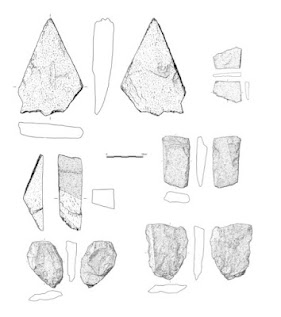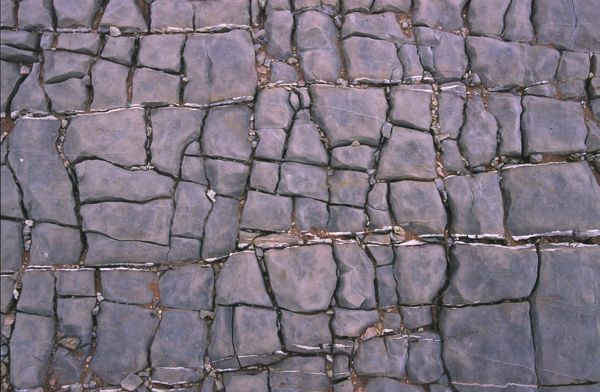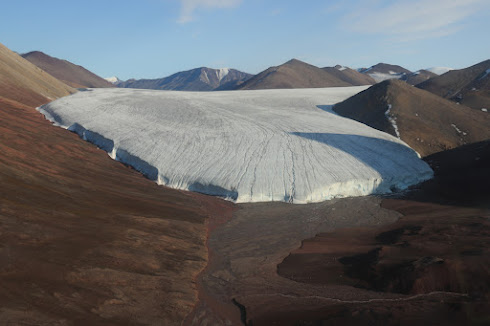There has been an interesting discussion on social media about "corporate responsibility" in multi-authored papers where scientific malpractice or fraud is exposed, or where there has been "interpretative inflation" and an over-claiming of research impact. The interpretation of "impact" is of course somewhat subjective, and the authors of papers will have a tendency to over-estimate the importance of what they have written while their opponents will tend to be more sceptical and maybe even cynical! Basic scientific fraud is of course easier to expose where it proves that experimental results are impossible for others to replicate or that phenomena described in digs or exposure have been invented or fabricated in a deliberate (or desperate) attempt to prove an hypothesis. Fraud -- whether in a lab, or in the statistical manipulation of data, or in the field -- is of course a very serious matter, and when it is exposed papers can be retracted and careers are often ruined.
In the discussions on social media the view was expressed by one contributor that in multi-authored publications the blame for fraud or interpretative inflation should be carried by the lead author but that maybe the junior authors or "hired experts" in a group should not be held culpable since they may well just have contributed radiocarbon dates, or geochemical or isotope analyses, or drone mapping to a project and they may not even have seen the text of an article prior to its publication. My response, in the context of a discussion about the collapse of the bluestone quarrying / lost circle narrative, is that it is invidious to single out one person (the mysterious MPP) as the villain of the piece, and that if authors have agreed to the use of their names on a multi-authored piece because they want a share of the limelight, then they should be prepared to "own" contents which are later shown to be nonsense.
Digging a bit deeper......
Quote:
Q: Should every co author be held accountable for the integrity of every aspect of a study or publication?
A: In most cases, authors will be expected to take joint responsibility for the integrity of the research and its reporting. However, if authors take responsibility only for certain aspects of the research and its reporting, this should be specified in the publication.This is an interesting open access paper:
https://www.ncbi.nlm.nih.gov/pmc/articles/PMC6096512/Gert Helgesson and Stefan Eriksson (2018)
Responsibility for scientific misconduct in collaborative papers
Med Health Care Philos. 2018; 21(3): 423–430.
Published online 2017. doi: 10.1007/s11019-017-9817-7
Abstract
This paper concerns the responsibility of co-authors in cases of scientific misconduct. Arguments in research integrity guidelines and in the bioethics literature concerning authorship responsibilities are discussed. It is argued that it is unreasonable to claim that for every case where a research paper is found to be fraudulent, each author is morally responsible for all aspects of that paper, or that one particular author has such a responsibility. It is further argued that it is more constructive to specify what task responsibilities come with different roles in a project and describe what kinds of situations or events call for some kind of action, and what the appropriate actions might be.
This is a long and detailed analysis -- just one paper in a huge list of studies on scientific ethics, academic malpractice and individual and corporate responsibility. The authors are particularly concerned with medical or bio ethics, so one might argue that "special circumstances" might apply. In pharmaceutical research, for example, fraudulent research (if not exposed) might have life or death consequences. But Helgesson and Eriksson get themselves into a bit of a tangle by refusing to acknowledge "evil intent" driven by commercial considerations -- something I have direct experience of in the journal Nature Biotechnology.
Much of the discussion in this paper is about the pros and cons of corporate responsibility in collaborative papers, and H&E suggest that it would be counterproductive for ALL authors to be blamed for the misdemeanours of one of their colleagues. However, journals nowadays increasingly require the authors of collaborative papers to specify EXACTLY what each author has contributed, eg. writing, text revision, geology, statistical analysis, radiocarbon dating, excavation team management, site surveys, etc.
Quote:
Co-authors of scientific papers should not be held responsible for misconduct unless they were personally involved in the actions constituting scientific misconduct, or encouraged misconduct, or knew about or suspected it without taking appropriate action.
The reason for this is that responsibility for research misconduct must be on par with the responsibility we assume in other cases of wrongdoing, and thus intention or recklessness needs to be present.
One consequence of this is that you should not be held responsible for your collaborators’ fraudulent behaviour if you were unaware of it and had no indications of what was going on. This can easily be the case in large collaborations where different groups make their contributions independent of one another, while a small group of researchers lead and orchestrate the work. This is not to say that researchers remain without any responsibility as long as they do not commit misconduct themselves, do not encourage others to do it, and remain ignorant of what their collaborators are doing. Every author shares the responsibility to be attentive to signs of misconduct and is under obligation to take some kind of action if they suspect fraudulent or too sloppy behaviour by collaborators in the study in which they participate. Every author also assumes a responsibility when publishing a paper to help rectify situations where their paper’s accuracy is questioned. However, on the whole it is not reasonable, nor ethically required, that collaborators spend time and effort scrutinizing what everyone else is doing to make sure it is scientifically and ethically sound, without any indications that this is needed.
There is another view, namely that there should be at least one researcher, the guarantor, who assumes full responsibility for the paper. This is the researcher who has overall responsibility for the quality of the research findings and integrity of the research methods.
This is another piece of guidance: “The primary author assumes responsibility for the publication, making sure that the data are accurate, that all deserving authors have been credited, that all authors have given their approval to the final draft; and handles responses to inquiries after the manuscript is published.”
And another: “The guarantor accepts full responsibility for the work and/or the conduct of the study, has access to the data, and controls the decision to publish.” The idea, in short, is to identify someone with responsibility for “the integrity of the work as a whole”.
Helgesson and Eriksson do not much like the idea of the single or lead author taking responsibility for the misdemeanours of members of their team, but their arguments strike me as very feeble. So if collaborators are not to share responsibility for the contents of a paper, and if the lead author can evade responsibility for the misconduct of assorted team members (by simply saying "I trusted him and I trusted his results. What a pity that my trust was misplaced.......") then scientific ethics are effectively abandoned. Journal editors and lead authors can publish fraudulent nonsense until somebody manages to find the maverick who is responsible for the dodgy piece of work which taints or devalues the quality of the wonderful work done by everybody else........
Scapegoats come in very handy sometimes!
This brings us back to the guiding principle mentioned at the head of this post. If co-authors are not identified as having limited or specified roles in the research work and writing of an article, then they must accept ownership of all of it. In cases of scientific fraud, they must accept joint responsibility for it or else demonstrate that they were not personally involved in the misconduct and did not encourage it. Further, in the case of a team that has worked together for many years, authors must expect to be challenged with these questions: "As a member of a close team, you must have known about or questioned the work of colleague X, and if so, why did you not take appropriate action to stop it?"
The Helgesson / Eriksson paper is very informative and thoughtful, but it is flawed in three major respects:
1. It assumes that in cases of serious scientific misconduct the blame lies with a single maverick or corrupt scientist who somehow betrays the trust of his colleagues.
2. It fails to recognize that many articles are written which are corrupt from start to finish because they are written by teams of scientists who are directly or indirectly controlled by commercial interests such as agri-chemical industries or "Big Pharma". These vested interests control project funding, choice of personnel, allocation of laboratory space, and the publication process. They even, in the worst cases, predetermine experimental results.
3. It does not take account of situations in which a whole team of maybe 15 people can work closely together, under the leadership of one charismatic figure, to prove a ruling hypothesis by whatever means they can devise, including the fabrication of field evidence, the selective citation of collected data, and the refusal to acknowledge that their ideas are disputed in the peer-reviewed literature by anybody else. They may also blur the lines between speculation and hard evidence, to the extent that assumptions are portrayed as facts.
Clearly, in case number three, we are looking at extremely serious or egregious breakdowns of academic standards, with large groups of people involved in conspiracies or scientific frauds. "But surely", I hear you cry, "if things are ever as serious as that, how is it that these people manage to get their papers published in respectable journals?"
Don't ask me that question. Address it to the Editor of "Antiquity" journal.............
===================
PS. This is how it should be done if authors wish to take responsibility (and credit!) for their own work but not necessarily for everything else in a multi-authored article. This new article in the field of glacial geomorphology has 16 co-authors:
PHB and SR designed the research and wrote the manuscript, constructed figures and tables with assistance from JD, IG, MB, GK; PHB, SR, EP, MB, DH, EH undertook fieldwork/sample collection. PHB and SB produced cosmogenic nuclide dating data; while CS provided 10Be exposure dating analytical facilities; PHB, LW, GK, SR, MB undertook radiocarbon dating. Kiteschsee Lake core data and interpretations were undertaken by SR, EP, SD (ITRAX-XRF), JD, VJ (diatom analysis) IG, SB, RM, CH (tephra counting, geochemical identification of tephra layers); PHB, SR, CS, SB, GK, EP, MB, JS edited initial drafts and all authors read and commented on the final version. The authors declare no competing interests.
















































